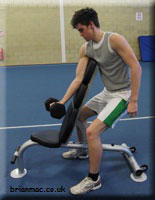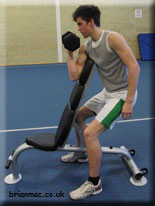

Biceps Curl Test
Testing and measurement are the means of collecting information upon which subsequent performance evaluations and decisions are made. In the analysis, we must consider the factors that influence the results.
Objective
The objective of this test is to assess the strength of the athlete's biceps.
Required Resources
To conduct this test, you will require:
- A set of dumbbells.
- Bench.
- Assistant.
How to conduct the test
This test requires the athlete to complete as many biceps curls as possible with no rest.
|
|
Analysis
Analysis of the test result is done by comparing it with the athlete's previous results for this test. It is expected that, with appropriate training between each test, the analysis would indicate an improvement in the strength of the athlete's biceps. The 1RM for the left and right biceps should not differ by 10%.
Target Group
This test is suitable for active athletes but not for individuals where the test would be contraindicated.
Reliability
Test reliability refers to how a test is consistent and stable in measuring what it is intended to measure. Reliability will depend upon how strictly the test is conducted and the individual's level of motivation to perform the test. The following link provides a variety of factors influencing the results and test reliability.
Validity
Test validity refers to the degree to which the test measures what it claims to measure and the extent to which inferences, conclusions, and decisions based on test scores are appropriate and meaningful. This test provides a means to monitor the effect of training on the athlete's physical development.
Advantages
- Minimal equipment is required.
- Simple to set up and conduct.
- The athlete can administer the test.
Disadvantages
- Specialist equipment is required.
References
- DOHONEY, P. et al. (2002) Prediction of one repetition maximum (1-RM) strength from a 4-6 RM and a 7-10 RM submaximal strength test in healthy young adult males. Journal of Exercise Physiology, 5 (3), p. 54-59
Page Reference
If you quote information from this page in your work, then the reference for this page is:
- MACKENZIE, B. (2005) Biceps Curl Test [WWW] Available from: https://www.brianmac.co.uk/biceptest.htm [Accessed

